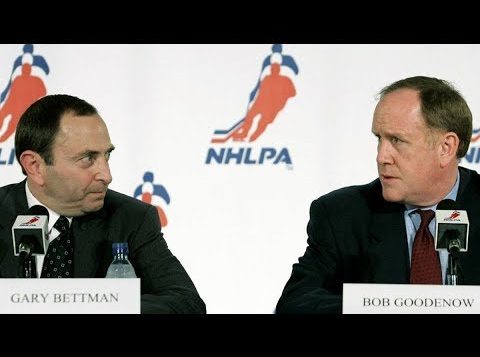This Day in Hockey History – July 13, 2005 – Lockout Capped
It had been a long 310 days, the longest lockout in professional sports. Finally, on July 13, 2005, NHL owners and the NHL Players’ Association (NHLPA) reached a tentative deal that would officially end the lockout on July 22.
The 1995 collective bargaining agreement between the NHL and NHLPA expired on September 15. 2004, and the lockout began the next day. Perhaps oversimplifying the issues, essentially Commissioner Gary Bettman and the owners felt that fundamental changes (including halting “runaway salaries”) needed to be made to ensure the stability of the league’s future. The NHLPA, led by Bob Goodenow, felt that the players deserved their fair share of the huge profits made by many owners. The two sides delayed truly negotiating until it was too late to save the season (the 88th), which was canceled on February 16, 2005.
This marked the first time in North America that an entire professional sport season was the victim of a labor dispute and the second time (after the 1994-95 MLB strike) that the whole postseason was canceled. For the first time since the Spanish Flu halted the 1919 finals, the Stanley Cup was not awarded. When an agreement still had not been reached after the season would have ended, everyone wondered whether there would be a new season.
To ensure the next season began on schedule, the NHL and NHLPA ramped up their efforts to settle things. They met every week in May and June and then for ten consecutive days starting July 4. Working overnight on July 12, they finally agreed on a deal. After making the announcement, they had to wait nine days until the meeting in which NHL board of governors could (unanimously) ratify the new 600-page collective bargaining agreement. Meanwhile, the NHLPA had to brief the players, who then voted on the agreement with 87% in favor. Thus, the lockout officially ended on July 22.
At the end of it all, the NHL and its players would have a lot of work to do in making up for the lost season and the negative public opinion. As Wayne Gretzky (managing partner of the Phoenix Coyotes) criticized, “At the end of the day, everybody lost. We almost crippled our industry. It was very disappointing what happened. For everyone to say, ‘All right, let’s forgive and forget, let’s move forward.’ That’s all fine and good, but it’s a lot easier said than done. It’s going to take a long time, it’s going to take a lot of hard work. We disappointed a lot of people. . . . We’ve got a lot of work ahead of us. It’s not going to all change and be all nice overnight.” Basically, the economy of and supporting the NHL had fallen into a depression. The lockout cost 1,000 jobs and $1.3 billion in players’ salaries. The owners lost $2.1 billion in revenue. That did not even count all the losses in advertisers and sponsors.
The primary change was the introduction of a salary cap (of $39 million), but that cap would be adjusted based on revenues. The players would take a pay cut, but the minimum pay was increased. They would be eligible for free agency at a younger age. The agreement also instituted rule changes meant to speed up the game and elevate excitement. The highlights of these included resolving overtime stalemates with shootouts, removing the red line, and cracking down on obstruction. Goalies would face new restrictions on the size of pads and a smaller area in which to play behind the net. To implement the new agreement, everyone had to wait ten days before signing anyone. At the time, only 288 players were under contract, leaving 400 still to be signed. The also had the entry draft to be held on July 30. On a side note, Bettman announced that the NHL would continue to play in the Olympics but would not hold All-Star games during those years.
Although the collective bargaining agreement was adjusted in September 2010, it officially expired on September 12, 2012. Another lockout immediately began and did not end until January 2013. That CBA will expire in 2022, but they can opt out as of September 1, 2019.
Additional Sources:
- Mike Commito, Hockey 365: Daily Stories from the Ice(Toronto: Dundurn, 2018), kindle edition.
- Hockey Chronicle: Year-by-Year History of the National Hockey League(Lincolnwood, Ill.: Publications International, Ltd., 2006), 662-666.
- “The Puck Drops,” Montreal Gazette, 14 July 2005, pp. A1-A3. “Lockout had no winner,”Montreal Gazette, 14 July 2005, pp. C1 and C3.
- “There are no real winners in interminable dispute,”Montreal Gazette, 14 July 2005, p. C3.














